Group 17 Big Data Analysis Presentation - Yaba College of Technology
VerifiedAdded on 2022/06/09
|16
|2477
|27
Presentation
AI Summary
This presentation, prepared by a group of ND2 Computer Science students at Yaba College of Technology, provides a comprehensive overview of Big Data Analysis. The presentation begins with an abstract highlighting the significance of big data in driving economic and societal changes, emphasizing the need for scalable algorithms to extract value from complex datasets. It then delves into the theoretical background, drawing on a study that explores how firms utilize big data while considering data protection. The presentation further examines various areas of application, including the education, media and entertainment, and government sectors. In education, it discusses the potential for customized learning programs and improved grading systems. In media and entertainment, it highlights the benefits of predicting audience interests and optimizing media scheduling. For the government sector, it emphasizes the utility of big data in welfare schemes, cybersecurity, and resource management. The presentation concludes by underscoring the importance of a strong data protection regime and the synergies between data protection and big data analytics.
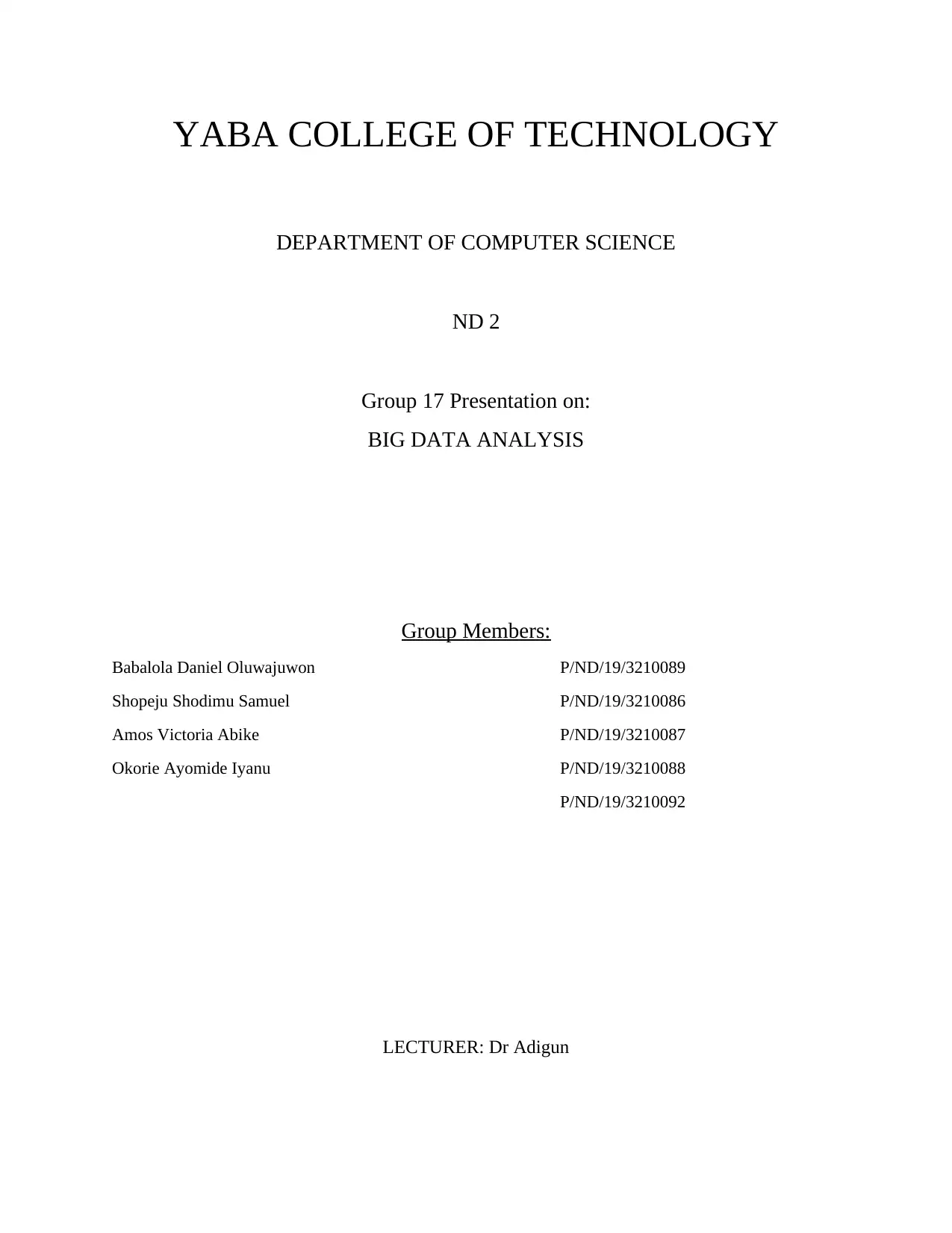
YABA COLLEGE OF TECHNOLOGY
DEPARTMENT OF COMPUTER SCIENCE
ND 2
Group 17 Presentation on:
BIG DATA ANALYSIS
Group Members:
Babalola Daniel Oluwajuwon P/ND/19/3210089
Shopeju Shodimu Samuel P/ND/19/3210086
Amos Victoria Abike P/ND/19/3210087
Okorie Ayomide Iyanu P/ND/19/3210088
P/ND/19/3210092
LECTURER: Dr Adigun
DEPARTMENT OF COMPUTER SCIENCE
ND 2
Group 17 Presentation on:
BIG DATA ANALYSIS
Group Members:
Babalola Daniel Oluwajuwon P/ND/19/3210089
Shopeju Shodimu Samuel P/ND/19/3210086
Amos Victoria Abike P/ND/19/3210087
Okorie Ayomide Iyanu P/ND/19/3210088
P/ND/19/3210092
LECTURER: Dr Adigun
Paraphrase This Document
Need a fresh take? Get an instant paraphrase of this document with our AI Paraphraser

Table of Contents
Abstract 3
Chapter One – Introduction 4
Chapter Two – Theoretical Background ` 5
Chapter Three – Areas of Application 11
Chapter Four – Conclusion 14
Reference 15
2
Abstract 3
Chapter One – Introduction 4
Chapter Two – Theoretical Background ` 5
Chapter Three – Areas of Application 11
Chapter Four – Conclusion 14
Reference 15
2
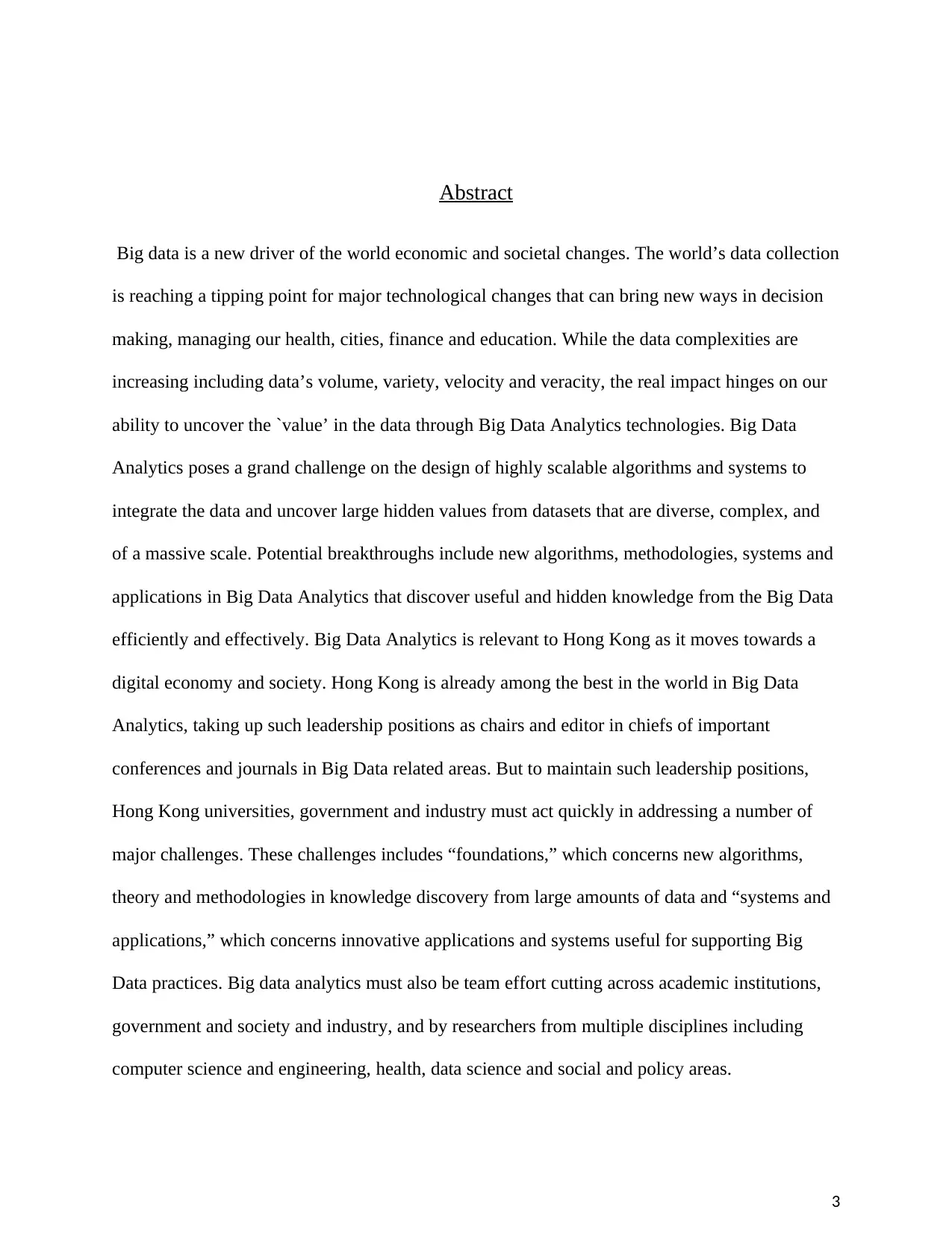
Abstract
Big data is a new driver of the world economic and societal changes. The world’s data collection
is reaching a tipping point for major technological changes that can bring new ways in decision
making, managing our health, cities, finance and education. While the data complexities are
increasing including data’s volume, variety, velocity and veracity, the real impact hinges on our
ability to uncover the `value’ in the data through Big Data Analytics technologies. Big Data
Analytics poses a grand challenge on the design of highly scalable algorithms and systems to
integrate the data and uncover large hidden values from datasets that are diverse, complex, and
of a massive scale. Potential breakthroughs include new algorithms, methodologies, systems and
applications in Big Data Analytics that discover useful and hidden knowledge from the Big Data
efficiently and effectively. Big Data Analytics is relevant to Hong Kong as it moves towards a
digital economy and society. Hong Kong is already among the best in the world in Big Data
Analytics, taking up such leadership positions as chairs and editor in chiefs of important
conferences and journals in Big Data related areas. But to maintain such leadership positions,
Hong Kong universities, government and industry must act quickly in addressing a number of
major challenges. These challenges includes “foundations,” which concerns new algorithms,
theory and methodologies in knowledge discovery from large amounts of data and “systems and
applications,” which concerns innovative applications and systems useful for supporting Big
Data practices. Big data analytics must also be team effort cutting across academic institutions,
government and society and industry, and by researchers from multiple disciplines including
computer science and engineering, health, data science and social and policy areas.
3
Big data is a new driver of the world economic and societal changes. The world’s data collection
is reaching a tipping point for major technological changes that can bring new ways in decision
making, managing our health, cities, finance and education. While the data complexities are
increasing including data’s volume, variety, velocity and veracity, the real impact hinges on our
ability to uncover the `value’ in the data through Big Data Analytics technologies. Big Data
Analytics poses a grand challenge on the design of highly scalable algorithms and systems to
integrate the data and uncover large hidden values from datasets that are diverse, complex, and
of a massive scale. Potential breakthroughs include new algorithms, methodologies, systems and
applications in Big Data Analytics that discover useful and hidden knowledge from the Big Data
efficiently and effectively. Big Data Analytics is relevant to Hong Kong as it moves towards a
digital economy and society. Hong Kong is already among the best in the world in Big Data
Analytics, taking up such leadership positions as chairs and editor in chiefs of important
conferences and journals in Big Data related areas. But to maintain such leadership positions,
Hong Kong universities, government and industry must act quickly in addressing a number of
major challenges. These challenges includes “foundations,” which concerns new algorithms,
theory and methodologies in knowledge discovery from large amounts of data and “systems and
applications,” which concerns innovative applications and systems useful for supporting Big
Data practices. Big data analytics must also be team effort cutting across academic institutions,
government and society and industry, and by researchers from multiple disciplines including
computer science and engineering, health, data science and social and policy areas.
3
⊘ This is a preview!⊘
Do you want full access?
Subscribe today to unlock all pages.

Trusted by 1+ million students worldwide
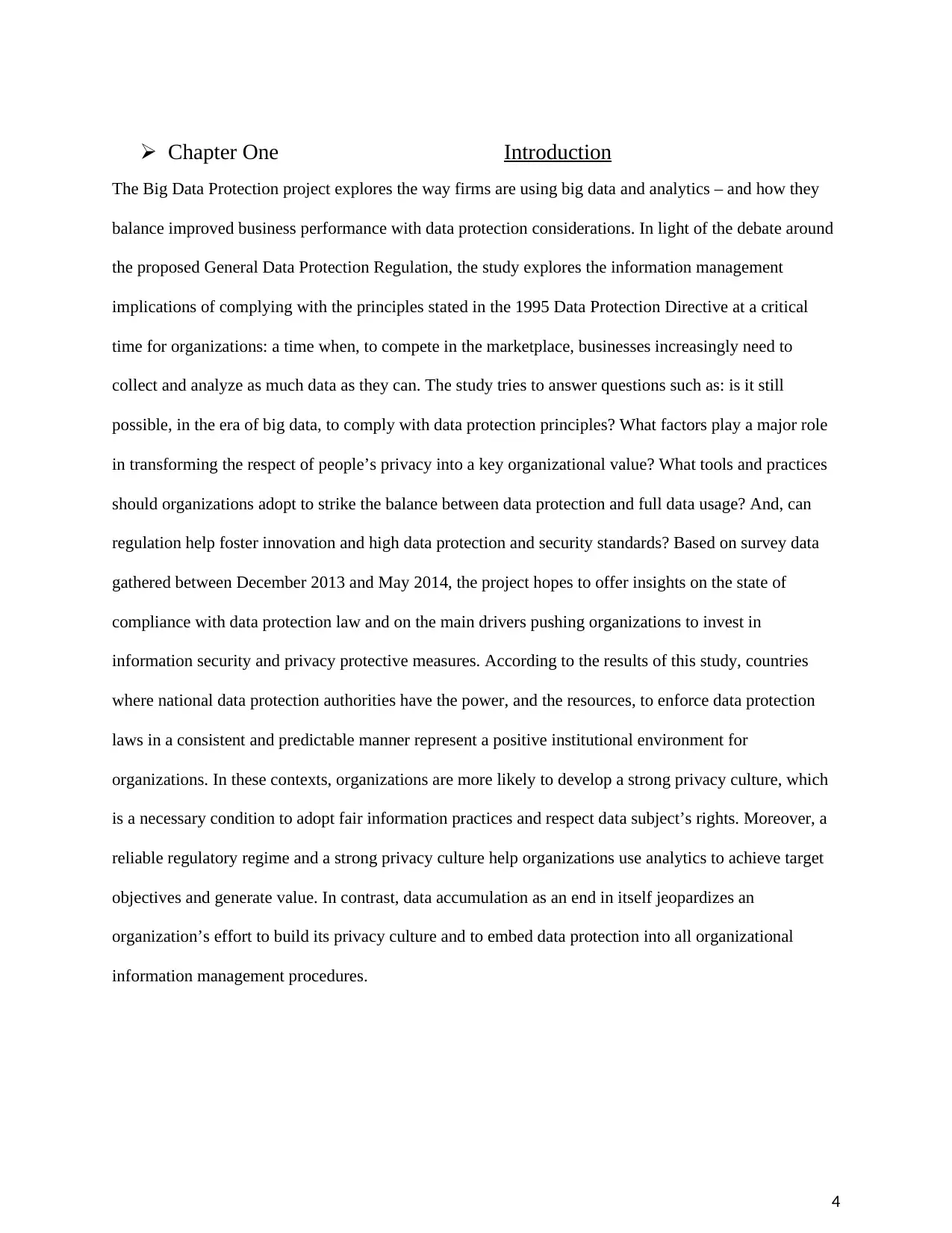
Chapter One Introduction
The Big Data Protection project explores the way firms are using big data and analytics – and how they
balance improved business performance with data protection considerations. In light of the debate around
the proposed General Data Protection Regulation, the study explores the information management
implications of complying with the principles stated in the 1995 Data Protection Directive at a critical
time for organizations: a time when, to compete in the marketplace, businesses increasingly need to
collect and analyze as much data as they can. The study tries to answer questions such as: is it still
possible, in the era of big data, to comply with data protection principles? What factors play a major role
in transforming the respect of people’s privacy into a key organizational value? What tools and practices
should organizations adopt to strike the balance between data protection and full data usage? And, can
regulation help foster innovation and high data protection and security standards? Based on survey data
gathered between December 2013 and May 2014, the project hopes to offer insights on the state of
compliance with data protection law and on the main drivers pushing organizations to invest in
information security and privacy protective measures. According to the results of this study, countries
where national data protection authorities have the power, and the resources, to enforce data protection
laws in a consistent and predictable manner represent a positive institutional environment for
organizations. In these contexts, organizations are more likely to develop a strong privacy culture, which
is a necessary condition to adopt fair information practices and respect data subject’s rights. Moreover, a
reliable regulatory regime and a strong privacy culture help organizations use analytics to achieve target
objectives and generate value. In contrast, data accumulation as an end in itself jeopardizes an
organization’s effort to build its privacy culture and to embed data protection into all organizational
information management procedures.
4
The Big Data Protection project explores the way firms are using big data and analytics – and how they
balance improved business performance with data protection considerations. In light of the debate around
the proposed General Data Protection Regulation, the study explores the information management
implications of complying with the principles stated in the 1995 Data Protection Directive at a critical
time for organizations: a time when, to compete in the marketplace, businesses increasingly need to
collect and analyze as much data as they can. The study tries to answer questions such as: is it still
possible, in the era of big data, to comply with data protection principles? What factors play a major role
in transforming the respect of people’s privacy into a key organizational value? What tools and practices
should organizations adopt to strike the balance between data protection and full data usage? And, can
regulation help foster innovation and high data protection and security standards? Based on survey data
gathered between December 2013 and May 2014, the project hopes to offer insights on the state of
compliance with data protection law and on the main drivers pushing organizations to invest in
information security and privacy protective measures. According to the results of this study, countries
where national data protection authorities have the power, and the resources, to enforce data protection
laws in a consistent and predictable manner represent a positive institutional environment for
organizations. In these contexts, organizations are more likely to develop a strong privacy culture, which
is a necessary condition to adopt fair information practices and respect data subject’s rights. Moreover, a
reliable regulatory regime and a strong privacy culture help organizations use analytics to achieve target
objectives and generate value. In contrast, data accumulation as an end in itself jeopardizes an
organization’s effort to build its privacy culture and to embed data protection into all organizational
information management procedures.
4
Paraphrase This Document
Need a fresh take? Get an instant paraphrase of this document with our AI Paraphraser
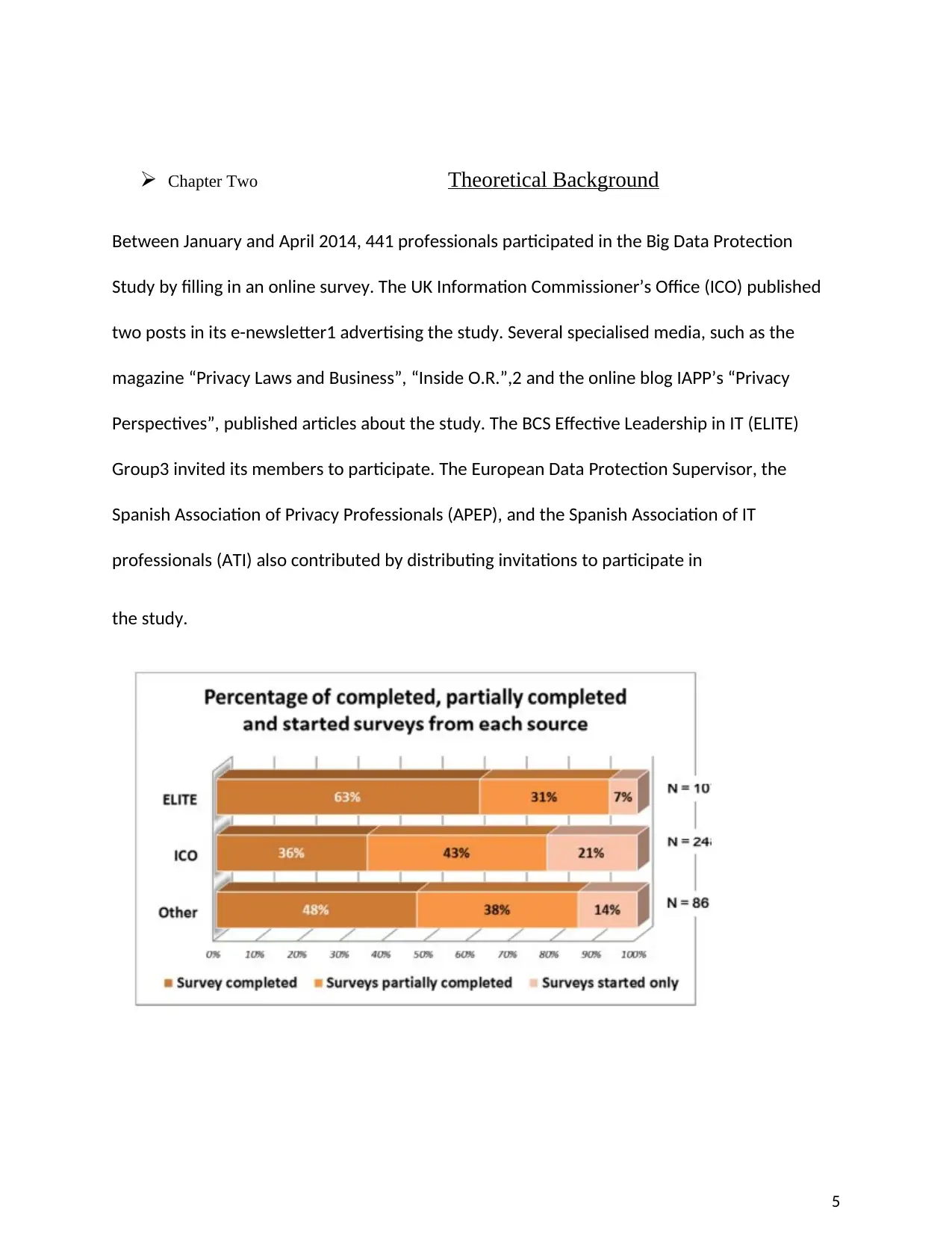
Chapter Two Theoretical Background
Between January and April 2014, 441 professionals participated in the Big Data Protection
Study by filling in an online survey. The UK Information Commissioner’s Office (ICO) published
two posts in its e-newsletter1 advertising the study. Several specialised media, such as the
magazine “Privacy Laws and Business”, “Inside O.R.”,2 and the online blog IAPP’s “Privacy
Perspectives”, published articles about the study. The BCS Effective Leadership in IT (ELITE)
Group3 invited its members to participate. The European Data Protection Supervisor, the
Spanish Association of Privacy Professionals (APEP), and the Spanish Association of IT
professionals (ATI) also contributed by distributing invitations to participate in
the study.
5
Between January and April 2014, 441 professionals participated in the Big Data Protection
Study by filling in an online survey. The UK Information Commissioner’s Office (ICO) published
two posts in its e-newsletter1 advertising the study. Several specialised media, such as the
magazine “Privacy Laws and Business”, “Inside O.R.”,2 and the online blog IAPP’s “Privacy
Perspectives”, published articles about the study. The BCS Effective Leadership in IT (ELITE)
Group3 invited its members to participate. The European Data Protection Supervisor, the
Spanish Association of Privacy Professionals (APEP), and the Spanish Association of IT
professionals (ATI) also contributed by distributing invitations to participate in
the study.
5
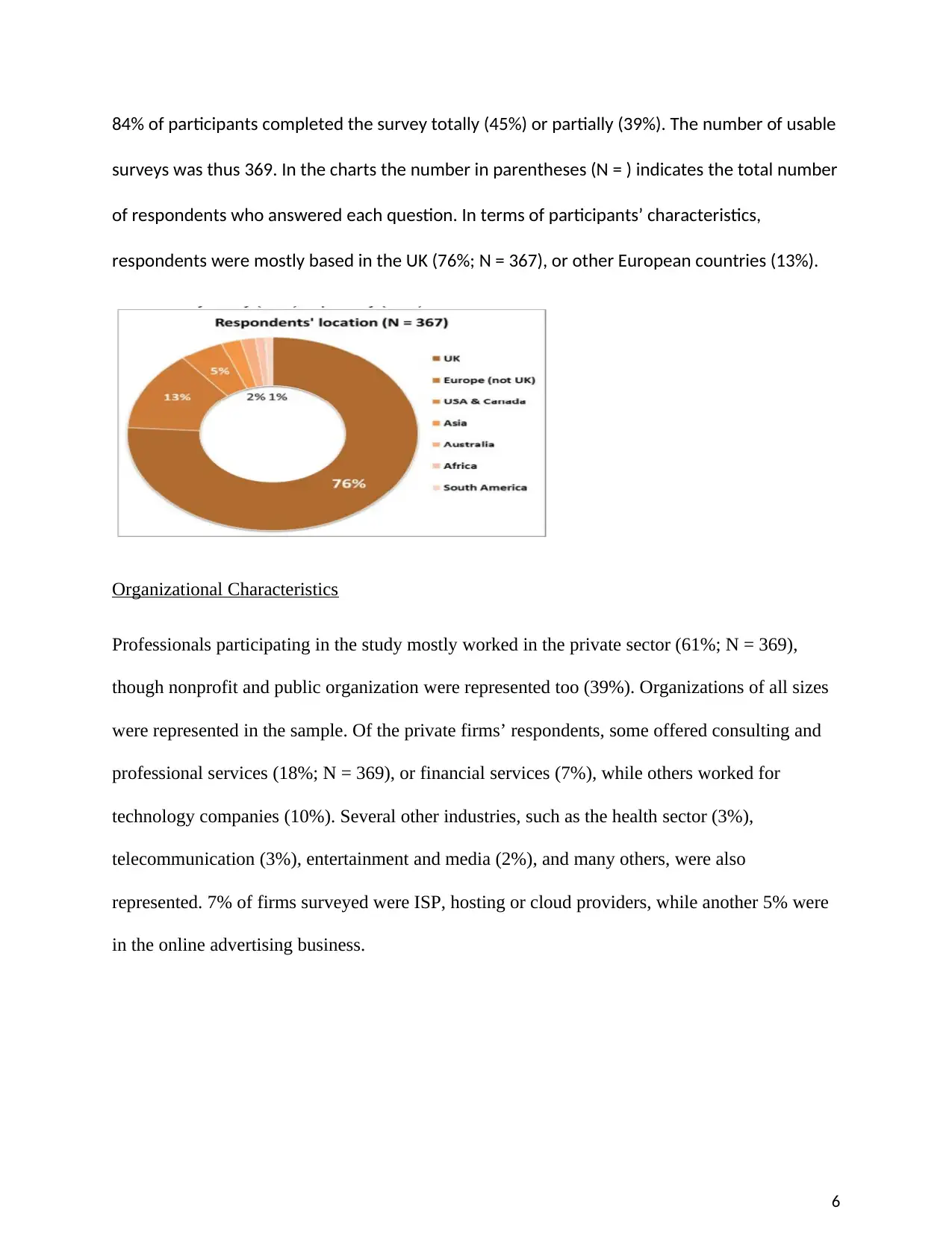
84% of participants completed the survey totally (45%) or partially (39%). The number of usable
surveys was thus 369. In the charts the number in parentheses (N = ) indicates the total number
of respondents who answered each question. In terms of participants’ characteristics,
respondents were mostly based in the UK (76%; N = 367), or other European countries (13%).
Organizational Characteristics
Professionals participating in the study mostly worked in the private sector (61%; N = 369),
though nonprofit and public organization were represented too (39%). Organizations of all sizes
were represented in the sample. Of the private firms’ respondents, some offered consulting and
professional services (18%; N = 369), or financial services (7%), while others worked for
technology companies (10%). Several other industries, such as the health sector (3%),
telecommunication (3%), entertainment and media (2%), and many others, were also
represented. 7% of firms surveyed were ISP, hosting or cloud providers, while another 5% were
in the online advertising business.
6
surveys was thus 369. In the charts the number in parentheses (N = ) indicates the total number
of respondents who answered each question. In terms of participants’ characteristics,
respondents were mostly based in the UK (76%; N = 367), or other European countries (13%).
Organizational Characteristics
Professionals participating in the study mostly worked in the private sector (61%; N = 369),
though nonprofit and public organization were represented too (39%). Organizations of all sizes
were represented in the sample. Of the private firms’ respondents, some offered consulting and
professional services (18%; N = 369), or financial services (7%), while others worked for
technology companies (10%). Several other industries, such as the health sector (3%),
telecommunication (3%), entertainment and media (2%), and many others, were also
represented. 7% of firms surveyed were ISP, hosting or cloud providers, while another 5% were
in the online advertising business.
6
⊘ This is a preview!⊘
Do you want full access?
Subscribe today to unlock all pages.

Trusted by 1+ million students worldwide
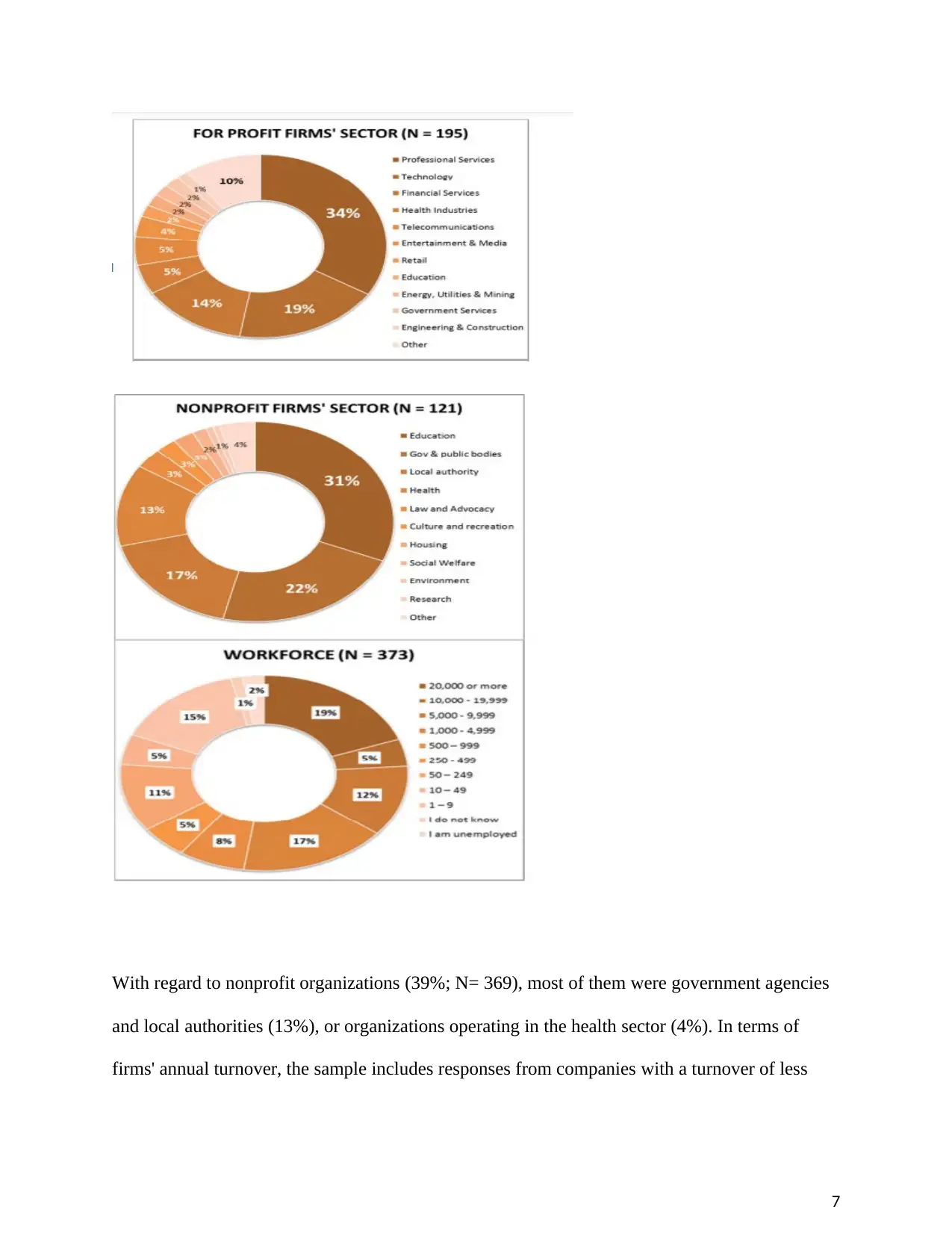
With regard to nonprofit organizations (39%; N= 369), most of them were government agencies
and local authorities (13%), or organizations operating in the health sector (4%). In terms of
firms' annual turnover, the sample includes responses from companies with a turnover of less
7
and local authorities (13%), or organizations operating in the health sector (4%). In terms of
firms' annual turnover, the sample includes responses from companies with a turnover of less
7
Paraphrase This Document
Need a fresh take? Get an instant paraphrase of this document with our AI Paraphraser

than £50,000 up to those with a turnover greater than £40 billion. In terms of economic
performance, while in the previous year respondents said that the income of nonprofit
organizations went down (52%; N = 114), revenues of for profit organizations participating in
the study not only went up (52%; N = 190), but in most cases were expected to keep growing in
2015 (57%; N = 189.
8
performance, while in the previous year respondents said that the income of nonprofit
organizations went down (52%; N = 114), revenues of for profit organizations participating in
the study not only went up (52%; N = 190), but in most cases were expected to keep growing in
2015 (57%; N = 189.
8
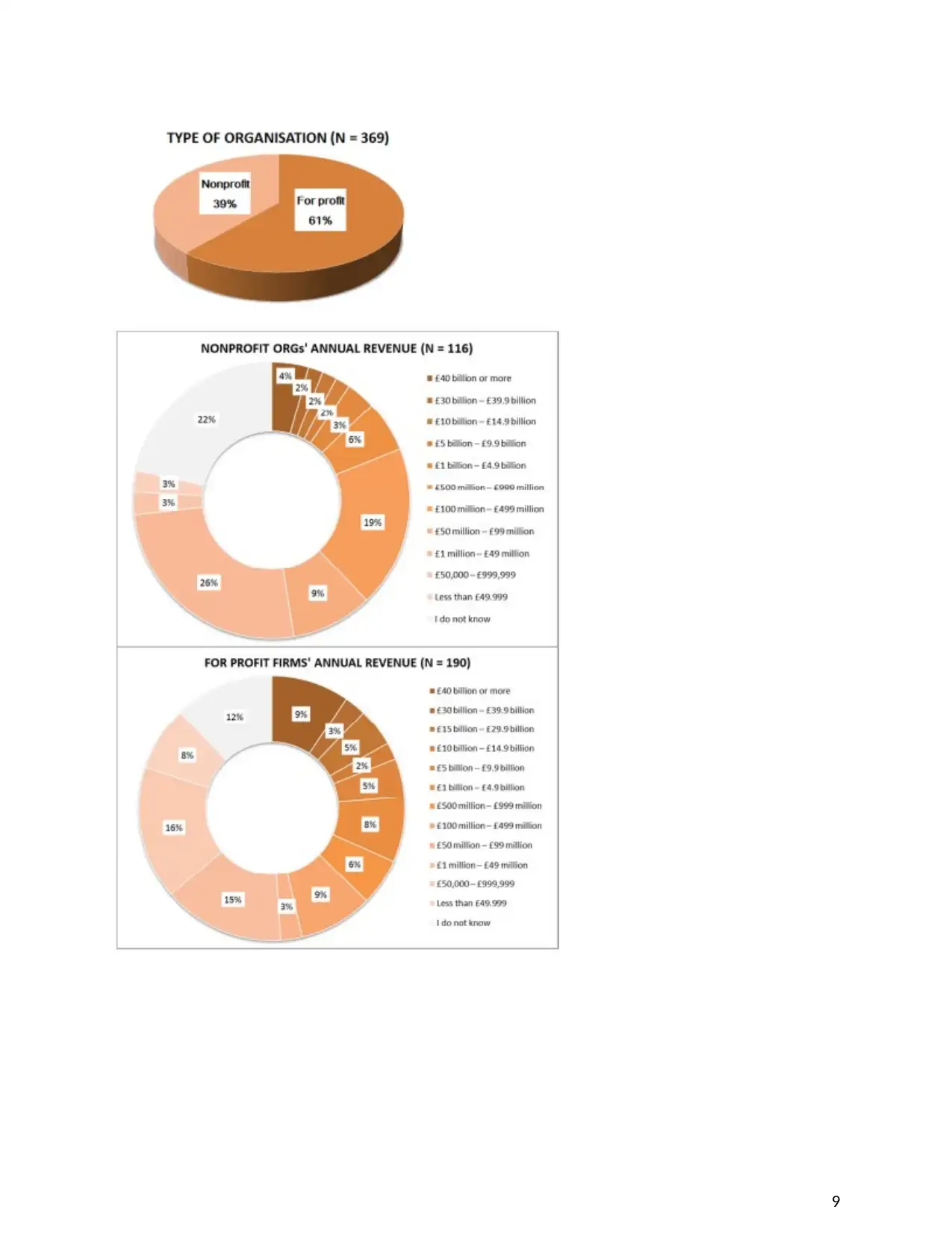
9
⊘ This is a preview!⊘
Do you want full access?
Subscribe today to unlock all pages.

Trusted by 1+ million students worldwide
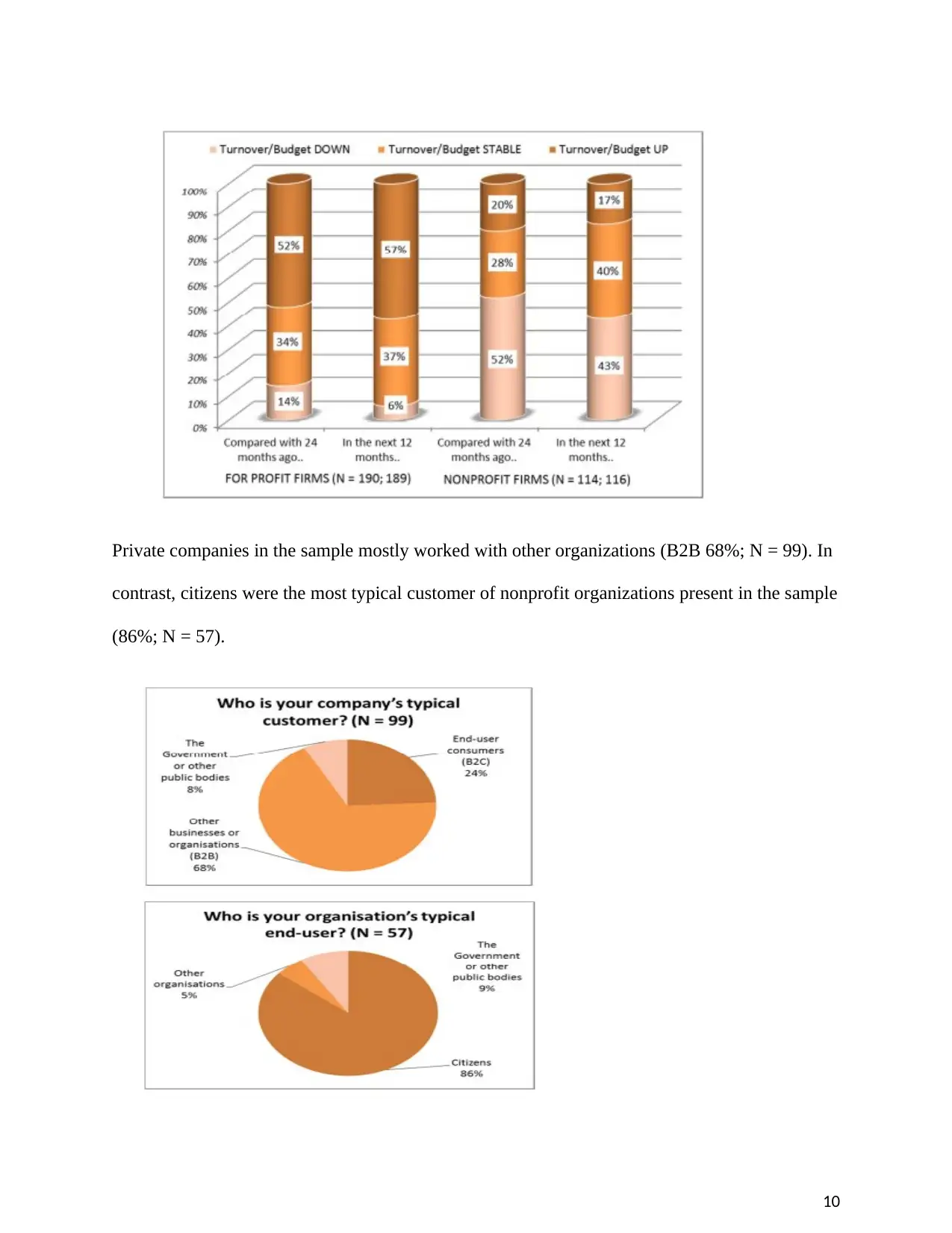
Private companies in the sample mostly worked with other organizations (B2B 68%; N = 99). In
contrast, citizens were the most typical customer of nonprofit organizations present in the sample
(86%; N = 57).
10
contrast, citizens were the most typical customer of nonprofit organizations present in the sample
(86%; N = 57).
10
Paraphrase This Document
Need a fresh take? Get an instant paraphrase of this document with our AI Paraphraser

Chapter Three Areas of Application
Big Data in Education Industry
The education industry is flooding with huge amounts of data related to students, faculty,
courses, results, and what not. Now, we have realized that proper study and analysis of this data
can provide insights that can be used to improve the operational effectiveness and working of
educational institutes.
Following are some of the fields in the education industry that has been transformed by big data-
motivated changes:
Customized and Dynamic Learning Programs
Customized programs and schemes to benefit individual students can be created using the data
collected on the basis of each student’s learning history. This improves the overall student
results.
Reframing Course Material
Reframing the course material according to the data that is collected on the basis of what a
student learns and to what extent by real-time monitoring of the components of a course is
beneficial for the students.
Grading Systems
New advancements in grading systems have been introduced as a result of a proper analysis of
student data.
11
Big Data in Education Industry
The education industry is flooding with huge amounts of data related to students, faculty,
courses, results, and what not. Now, we have realized that proper study and analysis of this data
can provide insights that can be used to improve the operational effectiveness and working of
educational institutes.
Following are some of the fields in the education industry that has been transformed by big data-
motivated changes:
Customized and Dynamic Learning Programs
Customized programs and schemes to benefit individual students can be created using the data
collected on the basis of each student’s learning history. This improves the overall student
results.
Reframing Course Material
Reframing the course material according to the data that is collected on the basis of what a
student learns and to what extent by real-time monitoring of the components of a course is
beneficial for the students.
Grading Systems
New advancements in grading systems have been introduced as a result of a proper analysis of
student data.
11
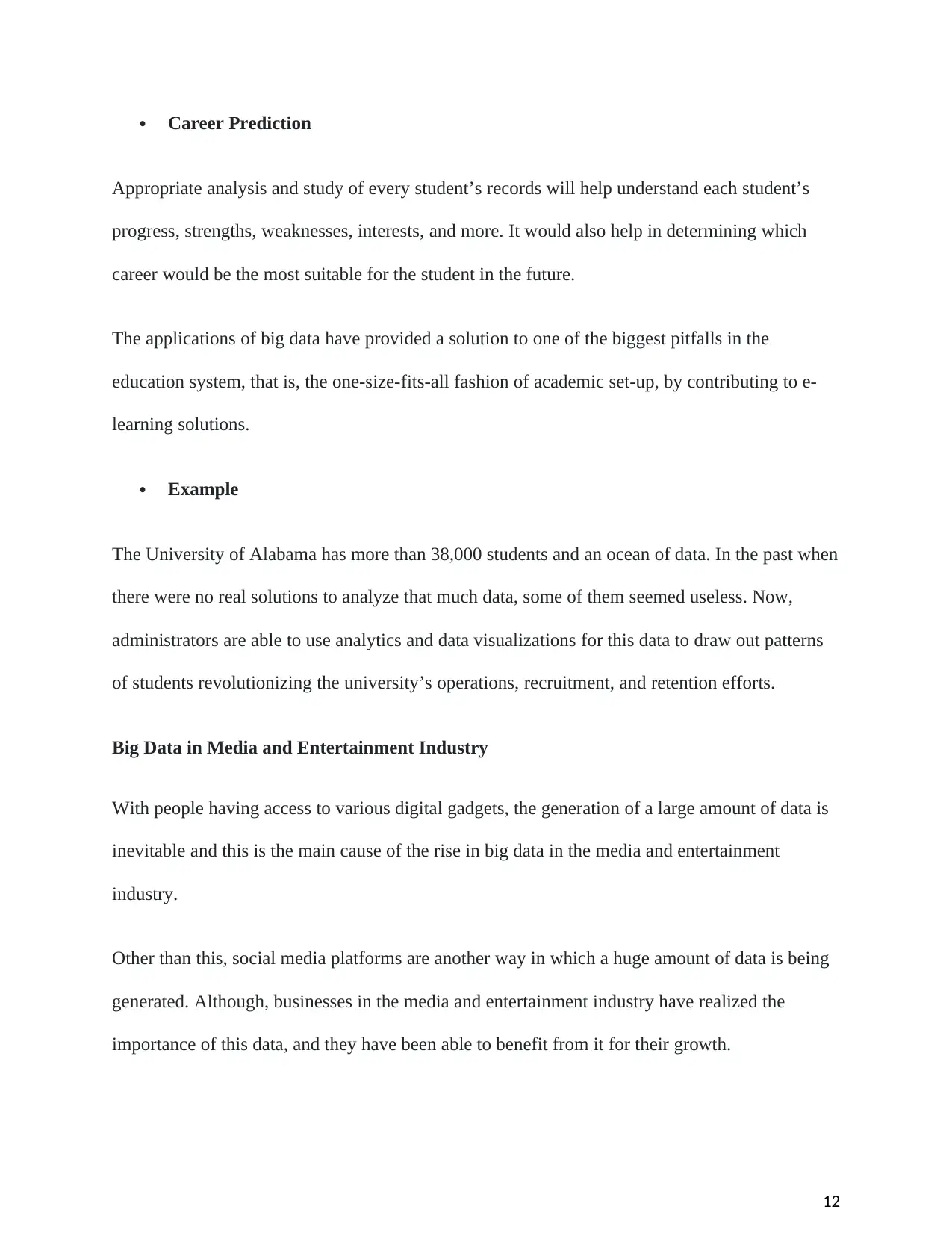
Career Prediction
Appropriate analysis and study of every student’s records will help understand each student’s
progress, strengths, weaknesses, interests, and more. It would also help in determining which
career would be the most suitable for the student in the future.
The applications of big data have provided a solution to one of the biggest pitfalls in the
education system, that is, the one-size-fits-all fashion of academic set-up, by contributing to e-
learning solutions.
Example
The University of Alabama has more than 38,000 students and an ocean of data. In the past when
there were no real solutions to analyze that much data, some of them seemed useless. Now,
administrators are able to use analytics and data visualizations for this data to draw out patterns
of students revolutionizing the university’s operations, recruitment, and retention efforts.
Big Data in Media and Entertainment Industry
With people having access to various digital gadgets, the generation of a large amount of data is
inevitable and this is the main cause of the rise in big data in the media and entertainment
industry.
Other than this, social media platforms are another way in which a huge amount of data is being
generated. Although, businesses in the media and entertainment industry have realized the
importance of this data, and they have been able to benefit from it for their growth.
12
Appropriate analysis and study of every student’s records will help understand each student’s
progress, strengths, weaknesses, interests, and more. It would also help in determining which
career would be the most suitable for the student in the future.
The applications of big data have provided a solution to one of the biggest pitfalls in the
education system, that is, the one-size-fits-all fashion of academic set-up, by contributing to e-
learning solutions.
Example
The University of Alabama has more than 38,000 students and an ocean of data. In the past when
there were no real solutions to analyze that much data, some of them seemed useless. Now,
administrators are able to use analytics and data visualizations for this data to draw out patterns
of students revolutionizing the university’s operations, recruitment, and retention efforts.
Big Data in Media and Entertainment Industry
With people having access to various digital gadgets, the generation of a large amount of data is
inevitable and this is the main cause of the rise in big data in the media and entertainment
industry.
Other than this, social media platforms are another way in which a huge amount of data is being
generated. Although, businesses in the media and entertainment industry have realized the
importance of this data, and they have been able to benefit from it for their growth.
12
⊘ This is a preview!⊘
Do you want full access?
Subscribe today to unlock all pages.

Trusted by 1+ million students worldwide
1 out of 16
Related Documents
Your All-in-One AI-Powered Toolkit for Academic Success.
+13062052269
info@desklib.com
Available 24*7 on WhatsApp / Email
![[object Object]](/_next/static/media/star-bottom.7253800d.svg)
Unlock your academic potential
Copyright © 2020–2025 A2Z Services. All Rights Reserved. Developed and managed by ZUCOL.





